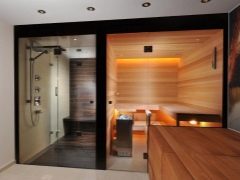How to choose and properly install a corner on the tub?

What is it?
A gap between the bathtub and the wall occurs inevitably - no matter how even and smooth the surfaces in the bathroom. If you provide for this nuance at the stage of finishing the walls with ceramic tiles, a beautiful tiled border along the bath will solve the problem. However, most often the resulting gap is noticed after the construction work is completed. Especially for such cases there are several options for sealing the gap, which do not require the dismantling of tiles.
The most popular solution is to use a corner, which is also called a skirting board or border for the bath. It is a long, narrow panel of plastic or ceramic. The protruding part of the baseboard is inserted directly into the gap, and the other two sides it is attached to the bathtub rim and to the tile.

What are they for and do they protect against leaks?
The corner on the bathtub has two main functions:
- First, it prevents water from seeping onto the floor under the tub, where there is often no waterproofing, which can cause water to seep into the lower floor. Even if this does not happen, then under the tub will be constantly kept damp, which will inevitably be mold and mildew.
- Secondly, it performs a certain decorative task - it disguises the ugly gap, which was formed between the wall and ceramic tile.
Plastic corner - this is far from the most reliable way to protect the floor in the bathroom from getting wet. Over time, this element falls into disrepair, so every few years it has to be replaced. This will not entail a large financial outlay, because it costs a corner for the bath for pennies. But for some people it is preferable to eliminate the gap once overhaul, rather than regularly perform minor repairs.

Types
Corners made of plastic
Plastic is one of the most suitable materials for finishing the bathroom, as it is resistant to moisture and temperature fluctuations. A big plus of plastic corners is the very low price, so even if you change the skirting board on the bathtub every year, it will be completely unnoticeable for your wallet. In addition, such corners have good plasticity, so you can seal the gap even with very uneven walls.


Corners of ceramic
Ceramics - the material is more durable and therefore more expensive than plastic. If you pick up the ceramic corner is similar in color to the tile, it will be almost invisible. Also, like plastic, ceramic is perfectly tolerant of high humidity conditions and temperature fluctuations. But this is an all-natural material, so many people prefer it. The disadvantage of ceramic corners is that they are easy to damage, since they are made of a fragile material.

What corner to choose?
When choosing a skirting board for the bathtub, carefully study all the options offered to you. The product must meet a few basic requirements - then it will last a long time and will reliably protect your bathroom from excessive moisture and its associated unpleasant consequences.
- The corner must be made of waterproof, not rotting material.
- The product must be both durable and resistant to deformation.
- The installation of the corner must be easy, quick and effortless.
- Bathroom skirting board must be able to bear influence of cleaning products for sanitary ware and ceramic tiles well.
- By color and style, the corner must match the bathtub and the wall finish.

How to properly install the corner on the bathtub?
Installation of the skirting made of ceramic and plastic is made differently, as each material has its own characteristics. Nevertheless, general rules still exist:
- If we are dealing with an old bathtub, you must first remove the previous corner and clean the surface of the tub and tiles from the remains of glue (or other mortar on which the skirting board was attached).
- The gap between the wall and the bathtub is better pre-caulked with installation foam - so the new corner will be more useful.
- Adhesive composition should be applied not only in the center, but also on the edges of the corner.

Alternatives for sealing the joint between the wall and the bathtub
There are other ways to eliminate the gap between the edge of the bathtub and the wall. Here are the most popular of them:
- Ceramic tile edging;
- Tape edging on an adhesive basis;
- silicone-based sealant for the bathroom;
- assembly foam;
- stacryl - a liquid substance that is used to restore acrylic bathtubs;
- a combination of different materials (for example, a combination of assembly foam + sealant + curb tape is quite common).
Thus, the options for caulking the gap between the wall and the bathroom can be endless, but a plastic or ceramic corner is the easiest and most affordable of them.







